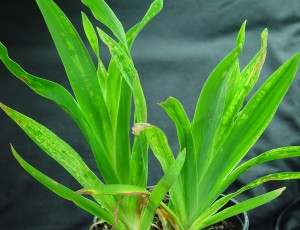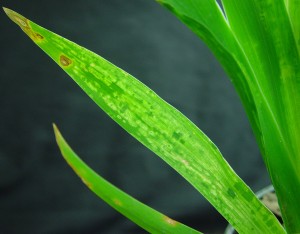Cucumber Mosaic Virus (CMV)
Pathogen: Cucumber Mosaic Virus (CMV)
Hosts Include: Aconitum, Aster, Astilbe, Campanula, Coreopsis, Delphinium, Echinacea, Gypsophila, Helianthus, Heuchera, Hosta, Ligularia, Lilium, Lysimachia, Oenothera, Penstemon, Phlox, Primula, Scabiosa, Sedum, and Viola. Many annuals and vegetables are also susceptible.
Symptoms: Symptoms vary widely depending on the host plant; possibilities include distortion of foliage, mosaic, mottling, stunting, and necrosis. Symptoms can resemble herbicide injury.
Spread: This virus is spread by several aphid vectors. Aphids aquire and transmit virus particles by probing and/or feeding on plant tissues. An aphid can transmit the virus to susceptible plants for up to two hours after acquiring the virus from an infected plant.
Management: Infected plants can not be treated and should be removed and destroyed. Suspect plants should be tested for CMV. Testing can be done by a diagnostic lab or on site using specialized tests available through several plant diagnostic companies. Weeds can also be infected with CMV, although they usually have no symptoms. Infected weeds in production areas are a source from which the virus can spread. Good weed control, especially of perennial weeds is important. Aphid populations should be controlled to limit potential insect vectors.





 Print
Print Email
Email




